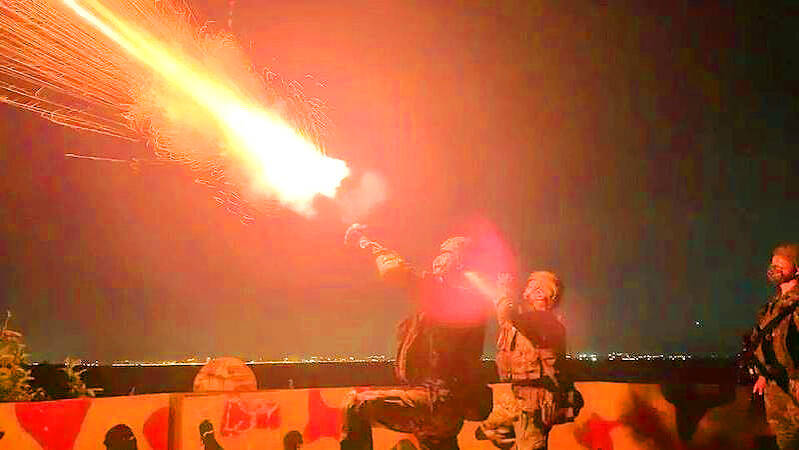Taiwan yesterday downed a civilian drone after weeks of complaints about incursions by uncrewed aerial vehicles from China, a sign Taipei is pushing back against Beijing’s efforts to encroach on its territory.
Taiwanese troops shot the drone down near Kinmen’s Shi Islet (獅嶼) at about noon after attempts to repel it failed, a statement from the garrison on the Taipei-held outpost just off China said.
That followed incidents on Tuesday and Wednesday in which Taiwanese soldiers fired warning shots and flares at civilian drones that approached the nation’s outlying islands.

Photo courtesy of retired Kinmen teacher Hung Ching-chang
The military is trying to reaffirm limits on Chinese presence near its territory after US House of Representatives Speaker Nancy Pelosi visited Taipei early last month.
President Tsai Ing-wen (蔡英文) in a speech on Tuesday urged the military to craft a strong response to China’s pressure campaign without prompting further escalation.
“Drones are part of China’s gray-zone tactics and cognitive warfare against Taiwan,” said Kuo Yu-jen (郭育仁), director of the Institute for National Policy Research in Taipei. “The incursions are an attempt to humiliate Taiwan’s military. Taiwan’s government first responded to it cautiously, and only turned tougher when they became more frequent.”

Photo courtesy of the Kinmen Defense Command
Chinese troops held unprecedented exercises for several days around Taiwan after Pelosi’s visit, including firing ballistic missiles over Taiwan proper.
Taipei has reported that an average of more than 10 Chinese warplanes have crossed the US-drafted median line that divides the Taiwan Strait each day since Pelosi’s visit, data compiled by Bloomberg News showed.
The drones’ flights over the outlying islands started in late July, although neither side has specified where they are coming from.
The Chinese Communist Party’s Global Times newspaper has said that “the frequent flights of civilian drones from the mainland [China] expose the Taiwan armed forces’ weak defenses.”
“China meant to test the response of Taiwan’s military in offshore islands like Kinmen by sending those drones, and also used these small-scale events to see how Taiwanese society responds to them,” said Crystal Tu (杜貞儀), assistant research fellow at the Institute for National Defense and Security Research. “They may also try to see whether there are loopholes in the procedure or response that they can further take advantage of.”
The Ministry of National Defense told lawmakers that China’s encroachments pose “severe military challenges,” a report seen by Bloomberg said.
Major General Lin Wen-huang (林文皇), who is in charge of combat planning at the ministry, told reporters that Taiwan would repel Chinese forces if they were to enter its territory.
“The closer the incursions are to Taiwan, the stronger our countermeasures will be,” Lin said.

MISINFORMATION: The generated content tends to adopt China’s official stance, such as ‘Taiwan is currently governed by the Chinese central government,’ the NSB said Five China-developed artificial intelligence (AI) language models exhibit cybersecurity risks and content biases, an inspection conducted by the National Security Bureau (NSB) showed. The five AI tools are: DeepSeek, Doubao (豆包), Yiyan (文心一言), Tongyi (通義千問) and Yuanbao (騰訊元寶), the bureau said, advising people to remain vigilant to protect personal data privacy and corporate business secrets. The NSB said it, in accordance with the National Intelligence Services Act (國家情報工作法), has reviewed international cybersecurity reports and intelligence, and coordinated with the Ministry of Justice Investigation Bureau and the National Police Agency’s Criminal Investigation Bureau to conduct an inspection of China-made AI language

LIMITS: While China increases military pressure on Taiwan and expands its use of cognitive warfare, it is unwilling to target tech supply chains, the report said US and Taiwan military officials have warned that the Chinese People’s Liberation Army (PLA) could implement a blockade within “a matter of hours” and need only “minimal conversion time” prior to an attack on Taiwan, a report released on Tuesday by the US Senate’s China Economic and Security Review Commission said. “While there is no indication that China is planning an imminent attack, the United States and its allies and partners can no longer assume that a Taiwan contingency is a distant possibility for which they would have ample time to prepare,” it said. The commission made the comments in its annual

‘TROUBLEMAKER’: Most countries believe that it is China — rather than Taiwan — that is undermining regional peace and stability with its coercive tactics, the president said China should restrain itself and refrain from being a troublemaker that sabotages peace and stability in the Indo-Pacific region, President William Lai (賴清德) said yesterday. Lai made the remarks after China Coast Guard vessels sailed into disputed waters off the Senkaku Islands — known as the Diaoyutai Islands (釣魚台) in Taiwan — following a remark Japanese Prime Minister Sanae Takaichi made regarding Taiwan. Takaichi during a parliamentary session on Nov. 7 said that a “Taiwan contingency” involving a Chinese naval blockade could qualify as a “survival-threatening situation” for Japan, and trigger Tokyo’s deployment of its military for defense. Asked about the escalating tensions

DETERMINATION: Beijing’s actions toward Tokyo have drawn international attention, but would likely bolster regional coordination and defense networks, the report said Japanese Prime Minister Sanae Takaichi’s administration is likely to prioritize security reforms and deterrence in the face of recent “hybrid” threats from China, the National Security Bureau (NSB) said. The bureau made the assessment in a written report to the Legislative Yuan ahead of an oral report and questions-and-answers session at the legislature’s Foreign Affairs and National Defense Committee tomorrow. The key points of Japan’s security reforms would be to reinforce security cooperation with the US, including enhancing defense deployment in the first island chain, pushing forward the integrated command and operations of the Japan Self-Defense Forces and US Forces Japan, as